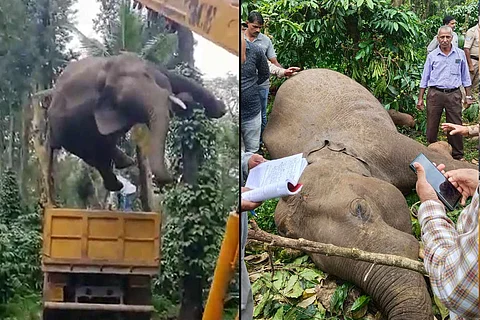

A male elephant was found electrocuted in Tamil Nadu's Tirunelveli district while attempting to uproot a palm tree on Monday, December 26. The tree fell onto an electric line, resulting in the elephant's death. This unfortunately is not an isolated incident in India, as electrocution is the leading cause of death for elephants in the country. In the past five years, 348 elephants have died from electrocution in India.
The information was provided by the Minister of State for Environment, Forest and Climate Change (MoEFCC) Ashwini Kumar Choubey in Lok Sabha on Monday, December 19 to a question asked by MP Adhir Ranjan Chowdhary. In addition to electrocution deaths, 80 deaths of elephants were caused due to train accidents, and 41 deaths were caused due to poaching in the last five years. In total, four elephants were poached in India this year, with three cases reported in Odisha and one in Tamil Nadu. All six cases of poisoned elephants were reported in Assam. Karnataka, which has the largest elephant population in the country, saw eight elephant deaths due to unnatural causes, including seven from electrocution and one from a train accident. Despite this, the number of elephant deaths due to unnatural causes has decreased nationally in the past five years.
The Union government under different ministries have also given several directions, notably to maintain minimum ground clearance for electric transmission lines for minimising the death of elephants due to electrocution as well as take measures to mitigate the impact of power transmission lines and other power infrastructure on elephants and other wildlife. But a large share of elephant deaths due to electrocution come from illegal electrified solar and electric perimeter fencing done by farmers to prevent elephants from entering their fields. These farmers illegally draw power to the fence from the main transmission lines, resulting in the immediate death of the pachyderms coming in contact with it. These fences can be lethal to elephants and there are laws to protect elephants. According to the Wildlife (Protection) Act of 1972, killing an elephant is punishable by a prison sentence of up to seven years. Despite that, Odisha has seen the highest number of elephant deaths due to electrocution, with 13 reported cases. Karnataka follows with seven reported cases, Kerala with six, Tamil Nadu with five, and Jharkhand and Chhattisgarh with four each. Uttar Pradesh and West Bengal have seen two reported cases each.
One solution that conservationists have proposed to address the issue of elephants coming in conflict with humans is the creation of elephant corridors. These are designated areas that allow elephants to safely migrate between forests in search of food and there are currently 101 elephant corridors in India. The MoEFCC response also states that critical elephant habitats have been notified as ‘Elephant Reserve’ for elephant conservation and to reduce conflict. So far 32 elephant reserves have been established in 14 major elephant states.
India is home to the largest population of Asiatic elephants, accounting for nearly 60% of the world's jumbo population. According to a 2017 estimate, India had a total of 29,964 wild elephants. Tamil Nadu, Kerala, Karnataka, Andaman and Nicobar Islands, Andhra Pradesh, and Maharashtra had the highest elephant population, with 14,612 individuals, while Arunachal Pradesh, Assam, Meghalaya, Tripura, Nagaland, the northern region of West Bengal, Manipur and Mizoram had 10,139 elephants. Karnataka had the highest number of wild elephants in India, at 6,049, followed by Assam with 5,719, Kerala with 5,706, and Tamil Nadu with 2,761.